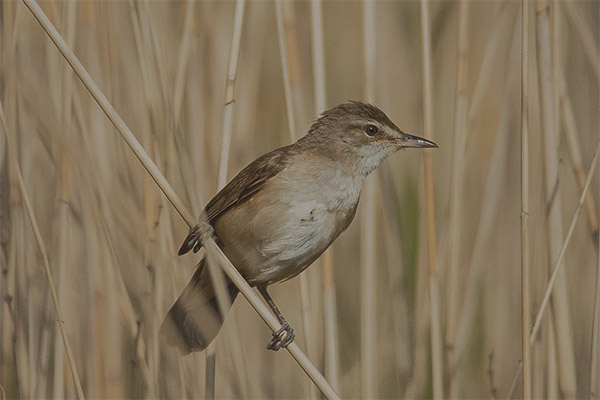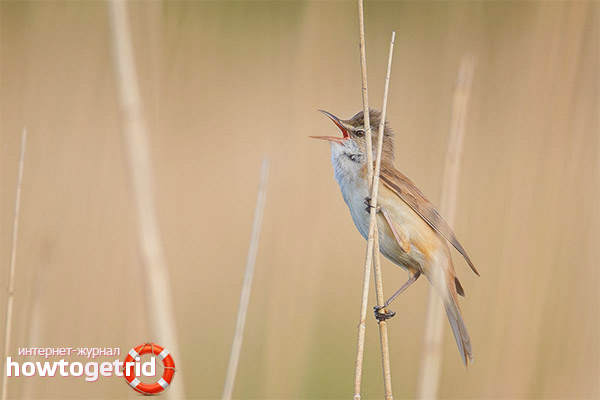The content of the article
Kamyshovka refers to the genus Slavok. The bird has a characteristic singing and melodious voice. According to its dimensional features, it is rather small, the body weight does not exceed the figures of 38 grams. In today's article we will study everything that affects representatives of the species, and also note their habitat features and other aspects.
Special features
If we compare the reed thistle with the sebaceous, then in this class the bird can be called rather large. Although in fact it is rather small. Sexual dimorphism is present, females are slightly smaller than males. In general, birds in length grow up to 20 cm with a maximum body weight of 38 grams. and wingspan of 30 cm.
Representatives of the male gender look ridiculous when the feathers on the parietal area are bruised while singing.As for the nature of the movement, it is almost the same as that of other warblers. Birds quickly jump from branch to branch.
Description and habitat
- Like all representatives of the species under discussion, these warblers cannot boast with an excessive number of speckles. In the area of the sockets there are white stripes resembling eyebrows. Below they are underlined by a dark longitudinal stripe horizontally.
- The plumage in the upper part of the body is painted beige with a brown tint. There are some light areas above the tail. The lower part of the body is light, closer to beige. The same shade is characteristic of the lateral sections of the body.
- In the neck with its front side, some birds have dark-colored mottles. They are not clear, almost not visible. Beak decent length, thick, painted pink-brown.
- The iris of the eyes is brown, the legs are brownish with dark patches. The males have a red mouth. The young by the type of plumage is red, the feathers themselves are loose.
- Most of the population is distributed in the Middle East.For the winter period, birds gather in flocks, after which they are sent to African countries. They are seen in the southern part of the Sahara Desert.
- In the spring, individuals fly back, they are met in the middle or late spring. Reverse departure is carried out in late summer or early fall. In the southern regions there are a lot of birds, in moderate lands the number is average.
Female and male
- In the presented species there is sexual dimorphism, which stands out exclusively in overall characteristics. Males are larger than females, otherwise they are identical.
- When the mating season begins, they are separated by behavior and singing. The songs are composed by males who try to please the females and conquer them.
- As for the construction of nests, then 2 partners take part in it. The incubation and rearing of offspring takes place in the same way.
Lifestyle
- Such birds try to live in dense and high reed beds. It can also be flooded places or areas where the reed is mixed with shrubs. In such a locality may be low trees.
- In most cases, individuals try to build nests not far from each other. Such a distance does not exceed even 10 m. Therefore, the existence of loose colonies is not excluded. Males, like most of this species often form pairs with two females at once.
- The dwelling at the same time has quite impressive sizes. It is shaped like a deep cup. As a building material are components of plant origin. Often, warblers use in their design a cane panicle.
- Up to 6 eggs can be maximally present in the clutch. The shell is most often painted in a bluish color. At the same time there are dark blotches and curls. The female is engaged in vidating offspring throughout the crescent. Both parents feed the young. Also, females can throw eggs to small reeds, like cuckoos.
- In most cases, the main diet of such birds are all kinds of insects. Individuals hunt prey, grabbing it from the surface of water, plants. Only in rare cases do birds hunt insects in the air. Also warblers feed on small berries.
Interesting Facts
- It is worth noting that in the wild there are more than 35 species of birds in question.
- More than 10 species live exclusively on a certain territory. That is, in other places such birds simply do not exist.
Reeds are quite interesting individuals. Some people even keep them at home. However, in captivity, the birds stop singing and begin to show increased aggression. In addition, the birds in question are completely unremarkable. They can easily be confused with the usual sparrow.
Video: Thrushy Reed (Acrocephalus arundinaceus)












To send